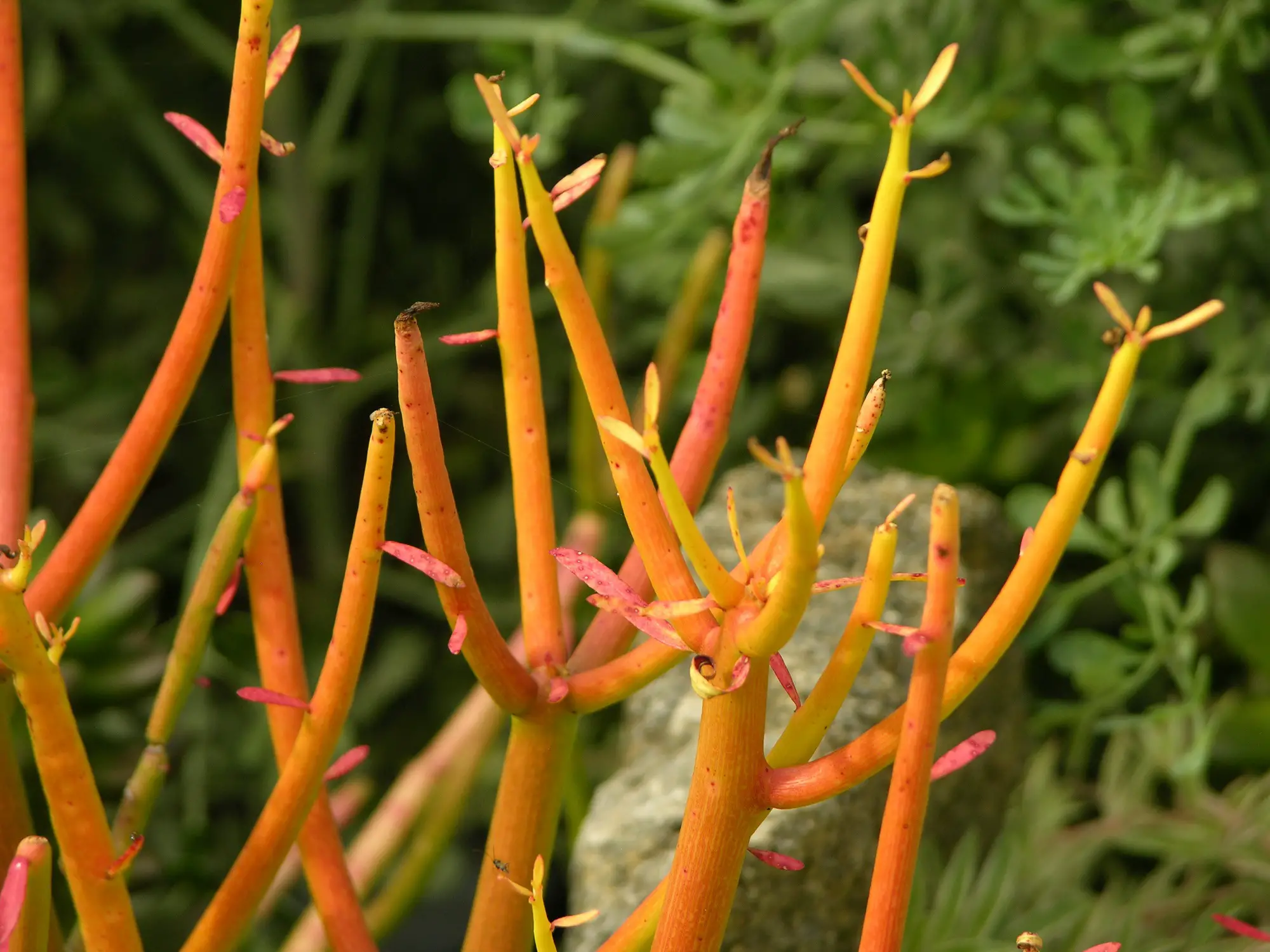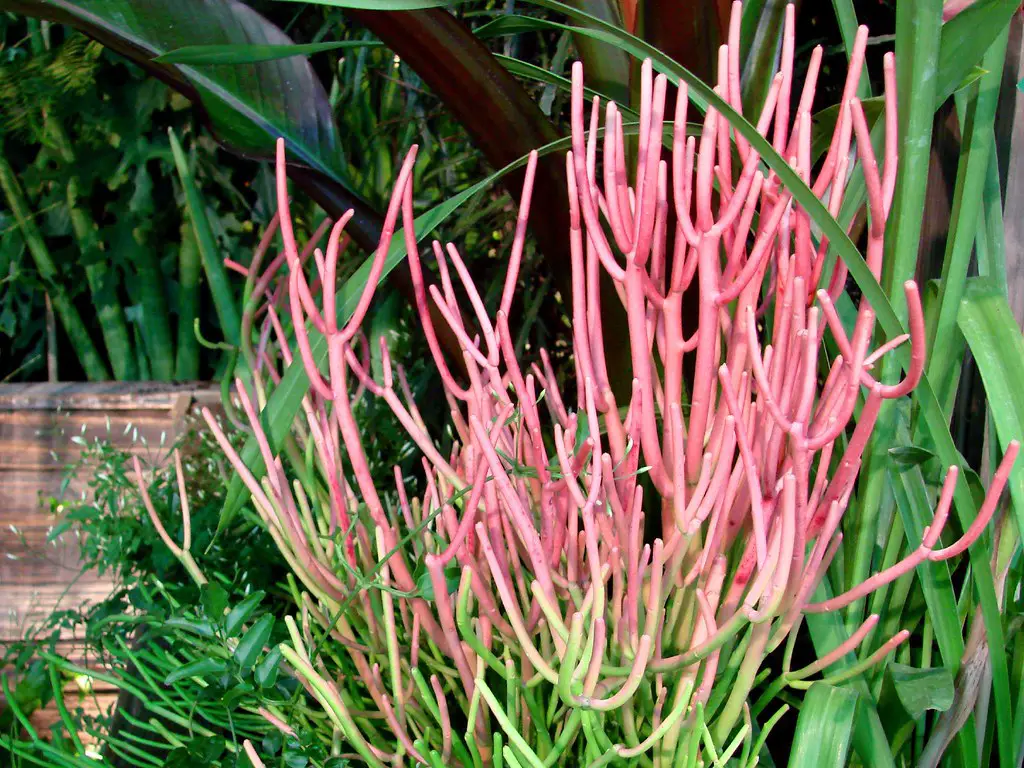Euphorbia tirucalli ‘Rosea,’ which is commonly known as Firestick Plant or Pencil Cactus, is a succulent bush that is known for the vibrant orange-red color these plants develop when exposed to enough light. The Firestick Plant’s stems are tall and slender, and the plant contains no obvious leaves.
Although Firestick Plants are rather hardy, they do best in warm environments with low humidity. Allow the plant’s soil to dry out completely between watering sessions.
The table below is a quick care guide for Firestick Plant.
| Scientific Name | Euphorbia tirucalli ‘Rosea’ |
| Common Names | Firesticks, Firestick Plant, Pencil Cactus, Pencil Tree |
| Lighting Requirements | Full sun or partial shade when grown outdoors South-facing or west-facing window when grown indoors |
| Watering Requirements | Water thoroughly and allow the soil to dry completely between watering sessions. Allow the soil to dry out and remain dry for a couple of days between watering sessions during the winter months. |
| Temperature | USDA Hardiness Zones 10-12 |
| Humidity | Thrives in low humidity |
| Soil | 2 parts sand, 2 parts potting soil, 1 part perlite |
| Repotting | 2-3 years |
| Fertilization | Fertilize once per year during the spring. Apply an all-purpose fertilizer diluted to half strength. |
| Toxicity | Milkey latex substance is toxic and can cause severe irritation. |
The rest of this article will serve as a detailed care guide for Firesticks.
About Firesticks
Euphorbia tirucalli ‘Rosea’, which is commonly known as Firesticks, Pencil Cactus, or Pencil Tree, has thin stems that develop into bushes or trees as the plant matures. Euphorbia tirucalli ‘Rosea’ is a cultivar of Euphorbia tirucalli. Euphorbia tirucalli is a succulent that grows in semi-arid climates. This plant grows in black clay soils within Africa with Euphorbia tirucalli being prominently present in northeastern, central, and southern Africa. It may also be native to the Arabian peninsula and has been introduced to other parts of the world such as Brazil, India, Vietnam, the Philippines, and Ghana.
Although Euphorbia tirucalli is commonly known as Pencil Cactus, these plants do not have spines and are generally considered to be the least cactus-like of the tree spurges.
Interestingly, Firesticks have medicinal value in some parts of the world. In northeast Brazil, Firesticks are used to fight syphilis. In other parts of the world, small amounts (the sap is an irritant in larger amounts) of the latex can act as a laxative. The bark/latex of this plant has several potential pharmacological purposes such as being an antibacterial, molluscicide, antiherpetic, and antimutagenic. It also has cocarcinogenic and anticarcinogen properties (Gupta et al., 2013).
Blooms
Firesticks produce cyathia, which are flower structures, at the top of the stems in stalkless clusters.

Why aren’t my Firesticks turning orange?
Many people add Firesticks to the garden because of the orange/red color that the stems turn during the winter months. However, only some varieties of Euphorbia tirucalli turn orange or red (e.g., Euphorbia tirucalli ‘Sticks on Fire’). If your Euphorbia tirucalli remains green when exposed to a season of direct, summer light, you have the green type of Firestick. This is good to know because Euphorbia tirucalli matures into a tree while Euphorbia tirucalli ‘Rosea’ grows into a bush.
Euphorbia tirucalli ‘Rosea’ needs exposure to sunlight to turn orange/red. Cooler temperatures are not critical to color change.
Where can you grow Firesticks?
Firesticks make good additions to container gardens. This makes it easy to bring your Firestick plants indoors before the first frost. They can also be grown as shrubs or bushes in USDA Hardiness Zones 10 through 12.
Firesticks can also be kept as an indoor plant as long as they are exposed to plenty of sunlight. These plants will also do well in greenhouses.
Lighting Requirements for Euphorbia tirucalli
Like most succulents, Firestick Plants like a lot of light. Adequate light exposure is absolutely critical if you want your Firestick Plant’s stems to turn that vibrant orange-red color that they are known for during the winter months.
Firestick Plants do best in full sun or partial shade when grown outdoors.
When grown indoors, these plants are definitely considered high-light plants. Firestick plant should be placed next to a south-facing or west-facing window when grown indoors. To ensure that all of the stems are receiving sun exposure, rotate the pot every couple of months.
Watering Requirements for Euphorbia tirucalli
Firestick Plants have watering needs that are typical of most succulents. Their succulent stems allow them to store excess water in order to withstand periods of drought. To properly water your Firestick Plants, water the soil thoroughly. Keep applying water until you see some flow coming out of the drainage holes. Then allow the soil to dry out completely between watering sessions.
During the winter months, allow the soil to completely dry out and remain dry for 2-3 days before watering again.
Firestick Plants grown indoors will require significantly less water than Firestick Plants grown outdoors. It is important to avoid overwatering your plant because these succulents are prone to root rot. For this reason, it is especially important to check the soil moisture before watering your indoor Firestick Plant.
Temperature and Humidity Suitable For Euphorbia tirucalli
Firestick Plants grow best in temperatures between 50°F and 70°F. However, they are hardy to temperatures as low as 25°F. If you are growing Firesticks outdoors in an area that gets cold during the fall/winter, bring your Firesticks indoors before the first frost. Firestick plants can also withstand temperatures as high as 100°F for several days.
As this plant is native to semi-arid climates, it does best in low humidity.
Best Soil For Euphorbia tirucalli
Like other succulents, Firesticks need to be grown in gritty, well-draining soil. A good soil mix for Firesticks would be comprised of two parts sand, two parts potting soil and one part perlite.
Repotting Euphorbia tirucalli
Repot your Firesticks every two to three years. This plant grows rather quickly, so they need to be repotted into a larger pot more often than other species of succulents.
Before your repot Firesticks, make sure the soil is dry. Then gently remove the plant from its pot while wearing gloves and brush away the old soil. Finally, put the Firestick Plant in its new pot and allow the pot to remain dry for about a week.
Fertilizing Euphorbia tirucalli
Firesticks do not require a significant amount of fertilizer. You only need to fertilize these plants once per year to keep them healthy and beautiful. Apply an all-purpose fertilizer diluted to half strength during the spring.
Propagating Euphorbia tirucalli
Firesticks can be propagated via stem cuttings. Wear gloves and eye protection when taking a cutting from your Firestick Plant as the milky sap within the stem is a skin irritant.
To propagate your Firestick Plant, select a branch comprised of young, healthy growth that is at least six inches long. Younger stems will have a more intense red color. Make a clean cut with a sharp knife. Run water over the cutting until the flow or white sap stops. Then place the cutting in a pot of well-draining soil. Keep the plant in a warm spot that is exposed to plenty of light. Keep the soil moist until the cutting roots.
Is Euphorbia tirucalli Toxic?
Like other Euphorbias, Firestick Plants contain a white, milky sap that is toxic to pets and humans. This sap irritates the skin and can cause eye damage. An article written by researchers at Kasturba Medical College reported that three patients whose eyes accidentally came into contact with the sap of Firestick Plants suffered severe eye irritation and blurring of vision for 10 to 14 days (Basak et al., 2009). These patients required medication to recover. For this reason, it is very important to wear gloves and eye protection when handling these plants.
If ingested, the white sap from Firesticks can cause vomiting and gastrointestinal discomfort.

